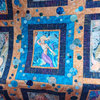New to FMQ
ritaweeda
13 years ago
More Discussions
I've only done small samples of FMQ and am hesitant to do a serious piece, but don't want to keep putting it off forever. I have just finished a top and as usual have come to the place for quilting decisions. It's all the same block design, I call it a cross patch, with sashings between all the blocks. (I posted a photo of it in a recent previous post on January projects.) I've looked at it several times wondering what to do with it. Then I happened to turn it over to the backing and was looking at that. It is a flannel all-over yellow with different color bands of swirls and butterflies in different colors. What I was thinking was, what if I turn it over and FMQ following the butterfly designs instead of doing something on the top? Have any of you ever done this?


K8Orlando
toolgranny
Related Professionals
Hercules Interior Designers & Decorators · Lake Elsinore Interior Designers & Decorators · Attleboro Flooring Contractors · Brookline Flooring Contractors · Jamaica Plain Flooring Contractors · Kendall West Flooring Contractors · Riverbank Flooring Contractors · Roseville Flooring Contractors · Saugus Flooring Contractors · Sycamore Flooring Contractors · Des Moines Furniture & Accessories · Fayetteville Furniture & Accessories · Annandale Furniture & Accessories · Hawthorne Furniture & Accessories · Jacinto City Furniture & Accessoriesnanajayne
rosajoe_gw
ritaweedaOriginal Author
toolgranny
Joan Dupuis
toolgranny